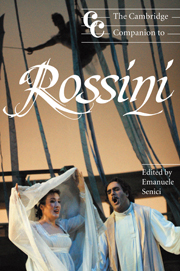10 - Tancredi and Semiramide
from Part III - Representative operas
Published online by Cambridge University Press: 28 September 2011
Summary
Tancredi and Semiramide, Rossini's first and last great Italian opere serie, bracket ten years of experimentation in the genre. Yet the two works do not fit into a ‘progressive’ developmental trajectory; rather, Rossini's Italian career seems to describe a loop, circling back to the elements and forms with which it had begun. Both works were written for Venice's Teatro La Fenice, Tancredi in 1813 and Semiramide in 1823. The prolific Gaetano Rossi wrote both librettos, basing each on a drama by Voltaire, Tancrède of 1760 and Sémiramis of 1748. Formally both operas consist exclusively of arias, duets and full-cast ensembles – neither includes a trio (the Andantino for Semiramide, Arsace and Assur ‘L'usato ardir’ is part of the second-act Finale), quartet, etc. – and they employ almost the same array of voice-types, featuring soprano heroine, contralto hero en travesti, bass villain and tenor. Yet these similarities only highlight the differences between the two works, which reveal much about Rossini's development in the seria genre.
The invitation to compose a serious work for La Fenice came in 1812, after the success of the farse that Rossini had written for lesser Venetian theatres. Tancredi, which was premièred on 6 February 1813, catapulted the young composer to fame. The opera won praise for its magnificent sets and its cast, led by the company's primo soprano assoluto Adelaide Malanotte Montresor in the title rôle. But above all the success was due to Rossini's music, infused with the rhythmic vivacity and inventiveness that would become his trademark.
- Type
- Chapter
- Information
- The Cambridge Companion to Rossini , pp. 137 - 158Publisher: Cambridge University PressPrint publication year: 2004



